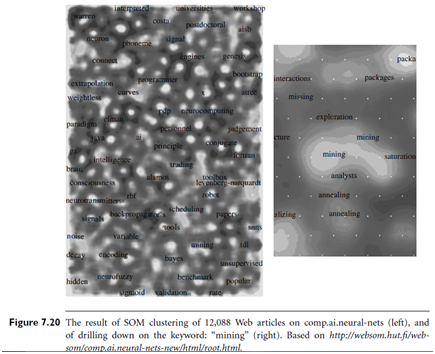Clustering High-dimensional Data
Introduction: Most clustering methods are designed for clustering low-dimensional data and encounter challenges when the dimensionality of the data grows really high (say, over 10 dimensions, or even over thousands of dimensions for some tasks). This is because when the dimensionality increases, usually only a small number of dimensions are relevant to certain clusters, but data in the irrelevant dimensions may produce much noise and mask the real clusters to be discovered.

Moreover, when dimensionality increases, data usually become increasingly sparse because the data points are likely located in different dimensional subspaces. When the data become really sparse, data points located at different dimensions can be considered as all equally distanced, and the distance measure, which is essential for cluster analysis, becomes meaningless.
To overcome this difficulty, we may consider using feature (or attribute) transformation and feature (or attribute) selection techniques.
Feature transformation methods, such as principal component analysis5 and singular value decomposition,6 transform the data onto a smaller space while generally preserving the original relative distance between objects. They summarize data by creating linear combinations of the attributes, and may discover hidden structures in the data. However, such techniques do not actually remove any of the original attributes from analysis.
This is problematic when there are a large number of irrelevant attributes. The irrelevant information may mask the real clusters, even after transformation. Moreover, the transformed features (attributes) are often difficult to interpret, making the clustering results less useful. Thus, feature transformation is only suited to data sets where most of the dimensions are relevant to the clustering task. Unfortunately, real-world data sets tend to have many highly correlated, or redundant, dimensions.
Another way of tackling the curse of dimensionality is to try to remove some of the dimensions. Attribute subset selection (or feature subset selection7) is commonly used for data reduction by removing irrelevant or redundant dimensions (or attributes). Given a set of attributes, attribute subset selection finds the subset of attributes that are most relevant to the data mining task. Attribute subset selection involves searching through various attribute subsets and evaluating these subsets using certain criteria. It is most commonly performed by supervised learning—the most relevant set of attributes are found with respect to the given class labels. It can also be performed by an unsupervised process, such as entropy analysis, which is based on the property that entropy tends to be low for data that contain tight clusters. Other evaluation functions, such as category utility, may also be used.
Subspace clustering is an extension to attribute subset selection that has shown its strength at high-dimensional clustering. It is based on the observation that different subspaces may contain different, meaningful clusters. Subspace clustering searches for groups of clusters within different subspaces of the same data set. The problem becomes how to find such subspace clusters effectively and efficiently.
In this section, we introduce three approaches for effective clustering of high-dimensional data: dimension-growth subspace clustering, represented by CLIQUE, dimension-reduction projected clustering, represented by PROCLUS, and frequent pattern based clustering, represented by pCluster.